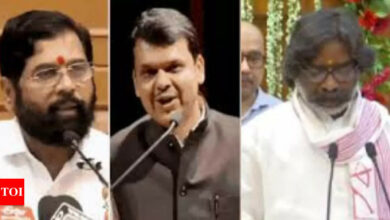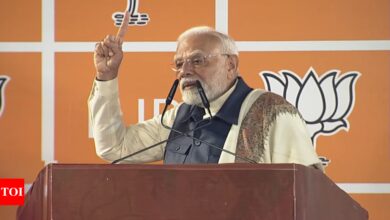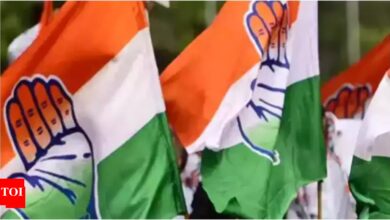India
Assembly poll results: ‘Maha’ saffron wave, spectacular Soren show; 10 key takeaways | India News – Times of India
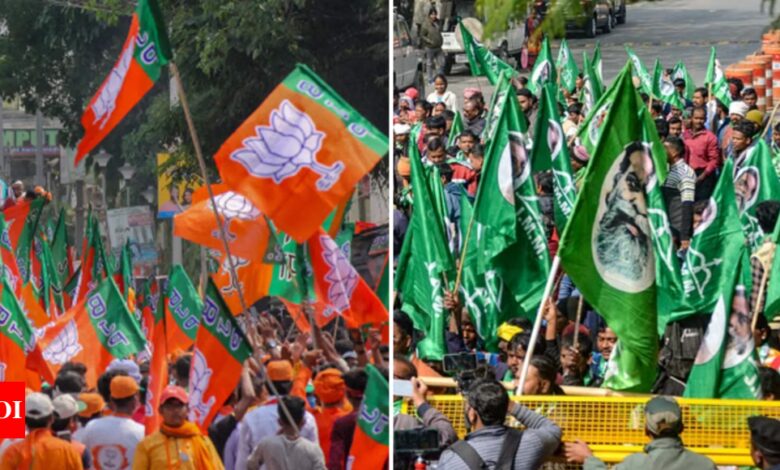
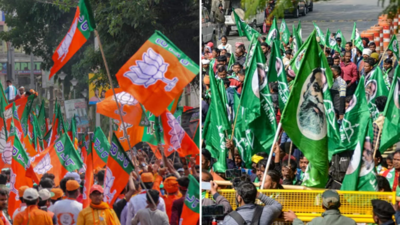

In Maharashtra, the BJP-led Mahayuti coalition has solidified its dominance, largely due to effective outreach to women voters through targeted welfare schemes. As per latest EC data, the Mahayuti alliance is expected to win over 200 seats while the MVA has been restricted to 49 seats.
Assembly Election Results
Meanwhile, in Jharkhand, the Jharkhand Mukti Morcha (JMM) has defied expectations by defeating anti-incumbency sentiment, showcasing its ability to connect with constituents through grassroots initiatives and focused welfare programmes. The JMM-Congress alliance is expected to win around 50 seats, as per the latest data by the Election Commission.
Here are 10 key takeaways from the election results:
BJP continues to lead and dictate Indian politics
The narrative of a BJP decline after the 2024 Lok Sabha elections now appears premature. The party has secured consecutive victories in Haryana and Maharashtra, even in states where it faced significant setbacks in the national polls. By swiftly addressing internal challenges, launching targeted welfare schemes, forging key alliances, and reconnecting with voters, the BJP has achieved its strongest-ever performance in both states, underscoring its resilience and strategic prowess.
These wins reaffirm the BJP’s position as the central pillar of Indian politics. Under the leadership of Prime Minister Narendra Modi and Amit Shah, the party has transformed into a robust election-winning machine. One or two poll losses may not make much of a difference in the upward and onward journey of the saffron party.
Since his arrival on the national stage after the 2014 general election, PM Modi has been the campaigner-in-chief for the saffron party. Election after election, he has been leading the BJP’s campaign and making it about Modi vs others even in state polls.
But he seems to have made a conscious and strategic withdrawal after the 2024 Lok Sabha polls. We are longer seeing carpet-bombing campaigns in state polls from PM Modi. This is reflected in the less number of Modi rallies during the poll campaign. There was no talk of “Modi ki guarantee” in Haryana, Maharashtra or Jharkhand elections. PM Modi and BJP are consciously trying not to wage a Modi-centric campaign in assembly elections.
PM Modi is still the most popular leader not only in India but across the world. But after being at the helm for over 10 years, he seems to be letting the state elections take the lead in local polls.
For BJP, the new formula seems to be to plan an election campaign from Delhi but fight it at local levels.
Freebies for women: The new winning formula?
Going by election results, the Mukhyamantri Majhi Ladki Bahin Yojana has emerged as a pivotal factor in the Maharashtra assembly polls, significantly influencing voter behavior and contributing to the Mahayuti alliance’s success. This scheme, initiated by the BJP-Shiv Sena-NCP government, provides monthly financial assistance of ₹1,500 to women aged 21 to 65 from families with an annual income below ₹2.5 lakh.
The BJP-Shiv Sena-NCP-led Mahayuti government strategically rolled out this welfare scheme post the Lok Sabha elections, providing monthly financial assistance of ₹1,500 to over 2.47 crore women across the state from July to November 2024. Between July and November 2024, the state disbursed ₹18,525 crore under the scheme, benefiting approximately 2.47 crore women. This substantial financial support has been credited directly to beneficiaries’ accounts, enhancing their economic stability.
The scheme’s implementation has notably increased women’s voter turnout. In districts like Pune, Nashik, Thane, Solapur, and Nagpur, which have the highest number of beneficiaries, women’s turnout rose by over 6% compared to the previous Lok Sabha elections. This surge arguably indicates the scheme’s effectiveness in mobilizing female voters.
The Jharkhand Mukti Morcha (JMM), led by Chief Minister Hemant Soren, too has capitalized on this trend through its women-centric initiative, the Mukhyamantri Maiyan Samman Yojana (MMSY). Launched in August 2024, this scheme provides financial assistance of Rs 1,000 per month to women aged 18-50, with plans to increase it to Rs 2,500 by December 2024. This initiative reportedly covered around 57 lakh women, contributing to a remarkable increase in female voter turnout—women outnumbered men in 68 out of 81 assembly seats.
The Congress, after a brief change of fortunes in the last one year, has again gone on a losing spree. The party has logged some notable wins in Himachal Pradesh, Karnataka and Telangana. Then it managed to nearly double its tally in the 2024 Lok Sabha elections.
However, the Congress seems to have lost its winning script again. In Haryana, it was supposed to romp home with an easy win. But it managed to mess up and suffered a massive loss. What was more painful for the party was that it could not dislodge BJP even after 10-year of incumbency. That too in a year where anti-incumbency has been the trend worldwide.
Next, Congress was supposed to win Maharashtra along with its MVA partners. But it has failed again.
The message from Haryana and Maharashtra are clear: Congress needs to find new issues and leaders to start winning state elections again.
Rahul Gandhi: Time for another yatra?
The Congress’s losses in the Haryana and Maharashtra assembly elections have once again cast a shadow over its revival efforts, despite its promising performance in the 2024 Lok Sabha polls. After securing nearly 100 seats in the general election and reclaiming the role of the official opposition, Congress seemed to be on a path of resurgence under Rahul Gandhi’s leadership. His **Bharat Jodo Yatra** had rekindled grassroots enthusiasm, reconnected with voters, and helped the party regain lost constituencies like Amethi. Yet, the back-to-back defeats in two key states highlight the challenges of maintaining momentum and translating Lok Sabha gains into state-level victories.
The Congress’s lackluster performance in Maharashtra and Haryana assembly elections will reignite criticism of Rahul Gandhi’s electoral approach. While he campaigned extensively for his sister Priyanka Gandhi in Wayanad, his efforts in Maharashtra—a key battleground—were limited to just eight rallies.
There is a perception that Rahul is more invested in waging an ideological battle against the BJP and RSS than in committing to the day-to-day demands of electoral politics. This approach risks portraying him as a politician who prioritizes symbolism over sustained campaign efforts.
Given these setbacks, it may be time for Rahul Gandhi to embark on another **yatra** to regain momentum for the Congress.
Index of opposition: Necessary but not a sufficient condition
On paper, it was a battle of equals. In fact, the Maha Vikas Aghadi (MVA) was supposed to be ahead of Mahayuti after the 2024 LS polls. But when it came to running the electoral campaign, the internal divisions came to the fore for the MVA. Comprising ideologically diverse parties—Congress, Shiv Sena (Uddhav faction), and NCP (Sharad faction)—the alliance struggled to maintain unity and project a cohesive front. Disagreements over seat-sharing, leadership roles, and campaign priorities became apparent during the election season, undermining the alliance’s ability to present itself as a credible alternative to the BJP-led Mahayuti. For example, the lack of a unified strategy on critical issues like Maratha reservations alienated key voter groups that traditionally supported the alliance.
This fragmentation also translated into a disjointed campaign narrative, with individual parties focusing on their own agendas rather than a common vision for the state. The alliance’s inability to forge a shared strategy diluted its messaging and made it difficult to counter the Mahayuti’s streamlined and aggressive campaigning.
Yogendra Yadav, political scientist-turned social activist, said that results show that “INDIA alliance did not have a game plan. They did not have a narrative.”.
BJP trumps Congress again
It’s back to the same old story again. The BJP had been beating Congress comprehensively in direct contests. It happened in 2014 and 2019 Lok Sabha elections, then in many state battles too.
In the 2019 Lok Sabha elections, the BJP and Congress went head-to-head in 190 constituencies, with the BJP securing a landslide victory in 175 seats, achieving a strike rate of 92%. The Congress, in contrast, managed to win only 15 seats, translating to a dismal strike rate of 8%.
But in 2024, direct contests between the BJP and Congress rose to 215 seats, with the BJP winning 153 (a 70% strike rate) and the Congress significantly improving to 62 seats, boosting its strike rate to 30% from 8% in 2019.
This improved strike rate against the BJP helped Congress to stop the saffron party from winning a majority on its own in 2024 LS polls.
But it seems, the 2024 LS polls were an exception. The BJP managed to beat Congress comprehensively in Haryana assembly polls.
Forget about the BJP defeating Congress in one-on-one fights. Maharashtra, the saffron party has emerged as the real winner with best-ever performance and with the highest strike rate among all parties.
The BJP has decimated Congress in direct contests in Maharashtra too.
The return of the RSS
There were reports about RSS and its members not working wholeheartedly for the BJP in the Lok Sabha results. This was attributed to BJP president JP Nadda’s comments that the party can win polls on its own and does not need RSS support anymore. But after the Lok Sabha results, BJP made extra efforts to win back full support of the RSS again. This was reflected in Haryana assembly elections.
In Maharashtra, it was deputy CM Devendra Fadnavis who himself said that he has sough the RSS support to help to fight ‘anarchists and vote jihadists’ in the assembly elections.
In an interview with TOI, responding to queries about his regular interactions with RSS officials post the Lok Sabha elections and the potential ideological support for BJP’s assembly poll campaign, Fadnavis said: “I am in constant touch with swayamsevaks. Remember, RSS doesn’t overtly work for any political party.”
Fadnavis said that Sangh affiliates are aiding Mahayuti to counter the opposition narrative.
Strong regional leaders behind wins
Jharkhand CM and leader of the Jharkhand Mukti Morcha (JMM) Hemant Soren, was instrumental in securing a historic victory for his party. His campaign strategy was multifaceted, focusing heavily on tribal pride and identity. Soren leveraged his personal narrative, including his recent legal battles and imprisonment on corruption charges, to resonate with voters. He positioned himself as a champion of tribal rights, emphasising issues like the Chhota Nagpur Tenancy Act that had previously sparked political turmoil against the BJP-led government.
Soren’s campaign was also marked by a strong familial presence, with his wife Kalpana Soren actively participating alongside him.
In Maharashtra, NCP’s Ajit Pawar, Shiv Sena’s Eknath Shinde and BJP’s Devendra Fadnavis emerged as key figures in their parties’ electoral strategies. Ajit Pawar’s focus on regional development issues and agricultural policies helped maintain a strong voter base compared to his uncle Sharad Pawar.
During his tenure as Chief Minister, Shinde held critical portfolios such as Public Works and Health. His governance was characterised by a focus on development projects that appealed to voters’ needs, enhancing his reputation as an effective leader capable of delivering results. This no doubt helped him trump Uddhav Thackeray’s SS-UBT.
On the other hand, Devendra Fadnavis, utilised his previous experience as CM to bolster the party’s campaign. His emphasis on infrastructure development and economic growth appealed to urban voters while also addressing rural concerns through targeted initiatives. Fadnavis’s established political presence and ability to connect with various demographics contributed significantly to the BJP’s performance in the state elections.
Split voting: Voters too are turning transactional
Like parties, voters are also increasingly becoming transactional while exercising their franchise. They are voting differently in state and Lok Sabha polls.
This split-voting was self-evident after Haryana and Maharashtra assembly polls. In the 2024 Lok Sabha polls, BJP and Congress both won 5 seats each. This had given hope to Congress that it was a party in ascendancy and could beat BJP in state polls, especially after 10-year incumbency of the saffron party. But to the surprise of many pundits, the BJP not only retained the state but went on to win highest-ever seats in Haryana.
The same-split voting trend has helped Mahayuti win against odds in Maharashtra too. In the 2024 general election, the INDIA block had won 30 out of 48 seats in Maharashtra. NDA could win only 17 seats in the state.
But, just after six months, Maharashtra voters have decided to bless Mahayuti again in the state polls. There is no denying now that parties can’t take voters for granted and they will have to plan as per the nature of the election.

